
|

1977 RECIPIENT
Robin Hopper — Potter
About the craftsperson
|
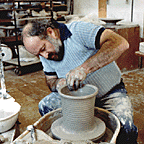
|
"Robin Hopper has been prolific in his production of ceramics — both
functional wares and one-of-a-kind pieces and uncompromising in the high
standards he sets for himself. Hopper's relationship to the land combines
the approach of the painter and the ceramist. Robin Hopper, the teacher,
author and ceramic artist of international acclaim, is above all a
knowledgeable, lively, generous individual. Through Robin's work one sees
his consistent interest in civilizations past and cultures present. The
many ideas derived from his travels, his curiosity, his scientific
understanding, and his ongoing experimentation and exploration have
resulted in unique colours and glazes and in interesting combinations of
form and design."
Patricia E. Bovey
Director
Art Gallery of Greater Victoria
Victoria
|
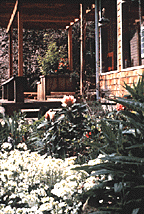
|
Robin Hopper feels that he acquired little technical knowledge of ceramics
at art college in England, where he grew up. However, he did gain a rich
historical appreciation of European, classical, and Oriental aesthetics.
Beyond this formal training, Hopper was influenced by three prominent
British potters. William Staite Murray and Hans Coper were among the first
British potters of this century to use modem studio pottery as a personal
medium of expression. Bernard Leach, who was born in China, brought the
styles and techniques of Oriental functional pottery to the Western world.
These were the influences Hopper brought to bear in his teaching and in his
studio after emigrating to Canada in 1968. Hopper experimented with the
medium, seeking a more scientific understanding of his craft and
rediscovering ancient techniques of pottery manufacture. He manipulated
different-coloured clays to recreate the seventh-century Chinese method of
making agateware, and moulded contrasting clays over rigid forms to reflect
the eighteenth century Japanese technique of "neriage".
|
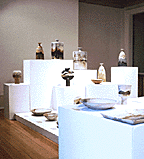
|
He altered the chemistry of ceramic glazes and colours, and applied
multiple glazes onto wheel thrown pottery; Later, he was drawn to the
ceramic accomplishments of ancient Mediterranean cultures.
|
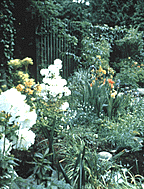
|
Passing on the results of this research to his students, apprentices and
interested professionals, Hopper has demonstrated tremendous skill and
energy as communicator. As a teacher, he emphasizes the technical aspects
of ceramics to his students rather than its aesthetics, which he feels can
be developed independently of scientific knowledge.
In his books, Hopper passes on what he has learned about ceramic glazes and
colour, pottery forms, and the history of ceramics. He has juried numerous
exhibitions, and has conducted workshops and given lectures at symposia in
Canada, the United States, Japan, New Zealand and Great Britain. He has
also served as a director, founding member or board representative on
several craft councils, and continues teaching at the Metchosin
International Summer School of the Arts, which he co-founded in 1985.
|
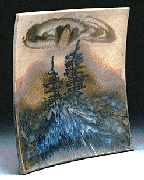
|
Landscape Plate, 1979
Porcelain, hand-built
Multiple glazes, trailed, poured and brushed;
glaze intagilio through wax resist
36 cm x 36 cm x 10 cm
CMC 86-116 (Bronfman)
|

|
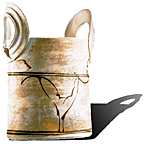
|
Basket Form, Classical Series, 1982
Porcelain, thrown and altered
Multiple glazes, sprayed and brushed
32 cm x 24 cm x 16 cm
CMC 86-117 (Bronfman)
|

|
|
Participating in all these activities has its drawbacks however, as Hopper
is obliged to schedule time for the production of his own work within a
full agenda of tours and lectures. Yet Hopper appears to thrive on this
hectic pace, and, his technical mastery and ability to demystify the
chemistry of ceramics, and his willingness over many years to share the
results of his research have already influenced a generation of potters.
His dedicated enthusiasm and participation in a contemporary ceramic
tradition continues to influence the ways in which potters produce both
functional ware and one-of-a-kind exhibition pieces.
|
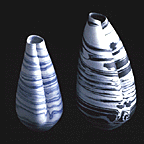 |
Shell Forms, 1974
Agate porcelain, thrown and altered
Unglazed
Left to right:
No. 2: 20 cm x 13 cm; CMC 86-114 (Bronfman)
No. 1: 26 cm x 14 cm; CMC 86-113 (Bronfman)
No. 5: 20 cm x 12 cm; CMC 86-115 (Bronfman)
|

|

